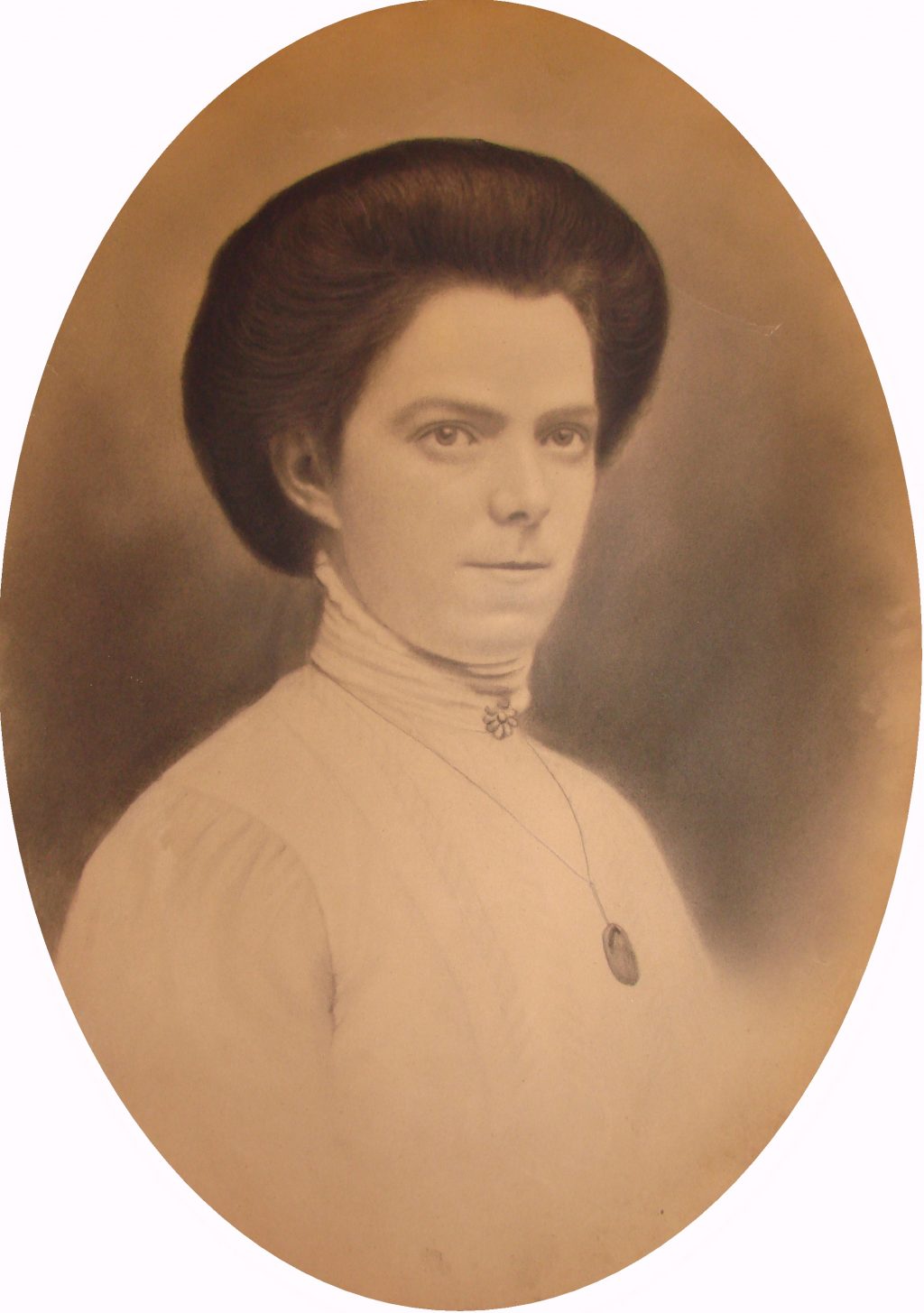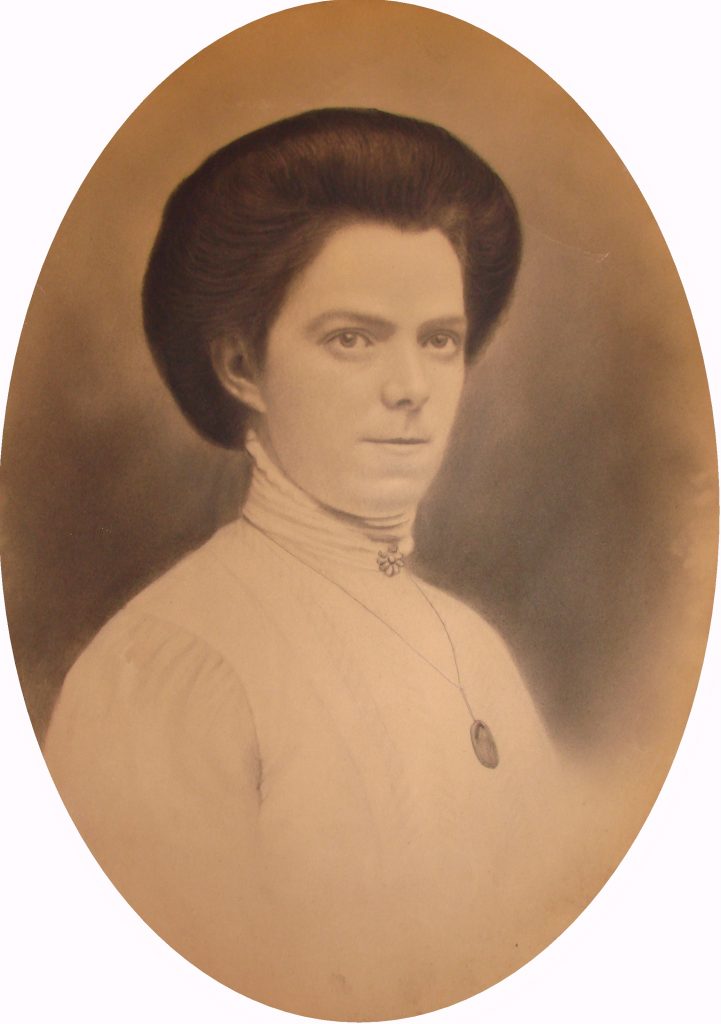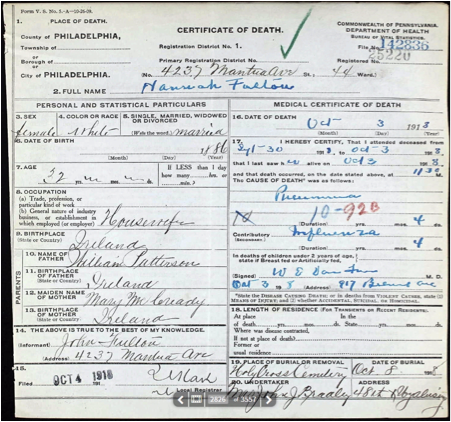
Hannah Patterson Fulton
A pregnant mother of six died days after the parade.
West Philadelphia.
John Fulton was my great-grandfather, and Hannah (Patterson) Fulton was my great-grandmother. John was from Edenderry, Co. Offaly (then King’s), Ireland; and Hannah was from Derry City, Co. (London)Derry, Ireland. They met, however, in Bonnybridge, Glasgow, Scotland where they had “step-immigrated” to work in a brick foundry before immigrating to Philadelphia in 1909.

Hannah’s father, William Patterson led the way in 1906 from Scotland to West Philadelphia. The rest of the 9 Pattersons arrived at the cramped, 3-bedroom, 1-bath address at 4823 Parrish St. in 1908. John arrived in February, 1909 and stuffed himself into the Parrish Street house with the others; Hannah arrived separately in June, 1909 due to her existing pregnancy, just 2 months after their wee Mary was born, and made the walls bulge a good bit more. Census documents show that Parrish Street never had fewer than 8occupants, but at times it may have held as many as 13. Incidentally, wee Mary would die just a month later from Cholera Infantum or, as the Irish knew it, the “Summer Complaint,” but that’s another story.
After bouncing around West Philadelphia’s neighborhoods from one rented home to the next, John and Hannah were able to rent a house to themselves at 4237 Mantua Ave. in 1917 or 1918–John would later buy this house in 1923; my mother, Theresa was born there. John worked for the Philadelphia Rail Road and Hannah worked fulltime bearing and caring for John’s appetite for creating children. Hannah was weakened by her current pregnancy. The family lore says that Hannah was a bit “sickly” due to all of the children she’d carried–by that time, 6 total, 2 of which had died. During her pregnancy with her last child, John Jr. in 1917 she was on bedrest in hospital for an entire month just to gain strength enough to deliver. A very susceptible, immunocompromised case she was indeed.
Just a few months after her 6th child was born Hannah was pregnant again in 1918. The Liberty Loan Bond drive behind the infamous, ill-advised parade in Philadelphia that caused the second wave of the Pandemic was on September 28, 1918 and just 5 days later Hannah was dead from pneumonia due to influenza. According to her death certificate (attached) she fell ill on September 30 and was dead on October 3, 1918. She lasted 4 days, never even making it into one of the overwhelmed Philadelphia hospitals. It is not known if any of the family attended the parade, but everything seems to align too perfectly.
Her obituary from Public Ledger, October 6, 1918, Page 12 column 5 read:
Hannah Fulton
Oct. 4, Hannah, wife of John Fulton and daughter of William and late Mary Patterson. Funeral, Tues., 9:30 a. m., 4237 Mantua ave. Int. Holy Cross Cem. Relatives of family invited.

As with all Irish tales, the suffering had only begun. Family lore says that the 4 children, Susan (my grandmother), Betz, Joey, and John, Jr., were “taken away” from John, presumably by the City, as he could not care for them and work. While in whatever situation they were placed, Joey was abused and lost the hearing in one of his ears.
One year after Hannah had died, John married Sarah Donnelly, a nanny from the Mainline whom he had met through mutual friends. They married for no reason but for her to mother his children–she refused to invite a West Philadelphia scandal by living with a man unwed, even if for innocent and charitable reasons. She was 16 years his senior. After what must’ve been an interminable year, John got his children back as a result. While the utilitarian arrangement of their marriage was well known, it was whispered in later years that John and Sarah truly grew to love each other. The aunts and uncles used to say behind their hands, “They slept in the same bed in later years…”
I’ve included so much background information to show the struggle of these people against the machinations of human society only to be brought so low by Nature and ignorance of it. My ancestors were immigrants and they were tough like all of West Philadelphia at the time, according to the Census. Hannah was a laborer in the brick foundry before being a housewife (and yet managed to be so lovely, picture attached). These were not weak, coddled people, but the wrong actions at the wrong time in the form of the Liberty Loan Parade being allowed despite the advice against it by doctors at the time was their downfall and that of 17,000 other Philadelphians; and not just to their life and health as the virus touched it but to their well being after it was gone in both distance and time. My ancestors traveled thousands of miles to 1918, and our species has traveled 102 years hence, yet at this decisive moment we seem to have gone nowhere.
Contributed by Rob Allen, great- grandson of Hannah and John Fulton.
